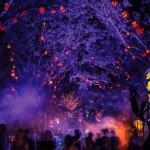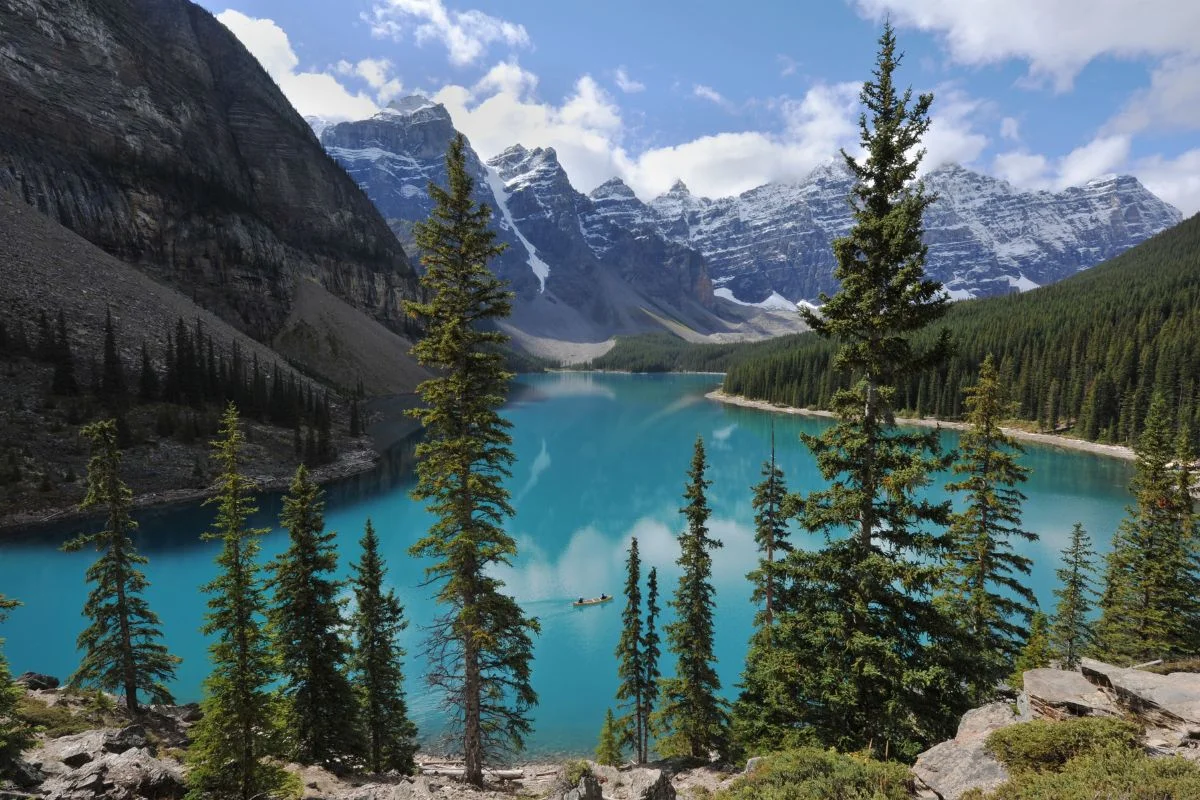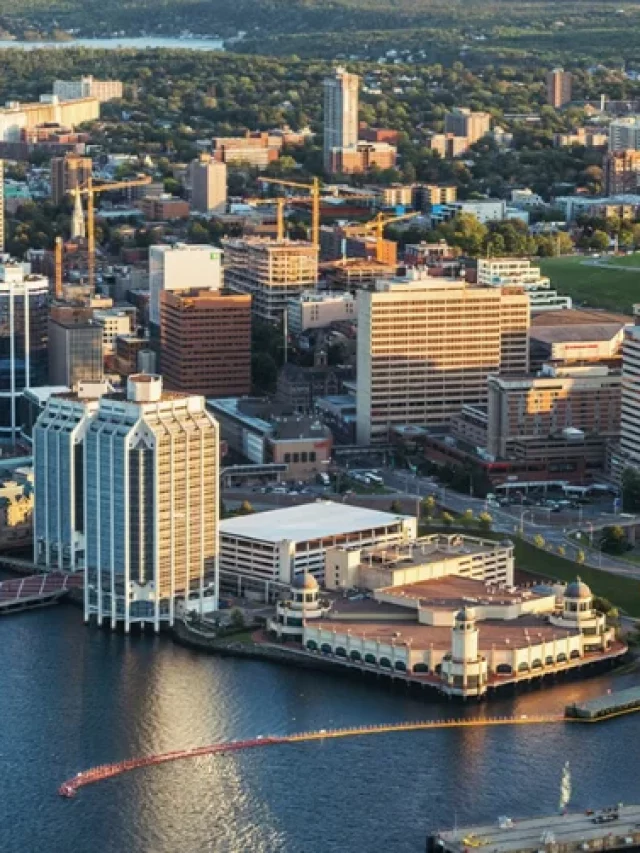For those who know, Banff National Park is one of the most beautiful places in the world. Boasting sub-alpine peaks, glaciers, turquoise lakes, and dense pine forests, this UNESCO World Heritage Site offers spectacular views around every corner. There is no shortage of photo spots in Banff National Park. In fact, there are too many good ones! From hotels to cafes to road-side pullouts to hiking trails and beyond, you could spend an entire week exploring new angles and locations for your next social media post or blog photo. Below you will find some of our favourite photo spots in Banff National Park ranging from easy photo ops that anyone can capture to more challenging locations perfect for any aspiring outdoor photographer.
1. Lake Louise
The iconic lake that sits below the towering mountains at the eastern boundary of Banff National Park, Lake Louise is an easy photo op for all. Visit the lake during the day and catch the reflection of the mountains in the still waters of the lake. Alternatively, plan a morning shoot, and you will have the opportunity to capture the foggy reflection on the lake. The iconic Fairmont Hotel sits just across the lake and makes for a great foreground element. You can also visit Lake Louise in the evening to shoot the alpenglow on the mountains. The alpenglow is the colour that the mountains turn shortly after sunset. During this time, Lake Louise is particularly popular with photographers as the landscape transforms from dark to colourful. The crowds, however, can make it difficult to get a clear shot of the alpenglow on the mountains, so you might want to visit Lake Louise for the alpenglow towards the end of the day.
2. The Columbia Icefield
If you are an avid photographer or avid outdoors person, this is an amazing location to visit. The Columbia Icefield is one of the largest frozen landscapes in the world and a UNESCO World Heritage Site. This massive icefield is the source of many of the world’s great rivers, including the Columbia River and the Fraser River. It is also home to massive glaciers and the world’s highest sub-alpine peak, Mount Columbia. The Columbia Icefield is a pretty easy photo spot. There are a number of viewpoints near the parking lots and along the Icefields Parkway, so you can easily find a view and snap some photos. Another option is to take a hiking tour on the Athabasca Glacier or the Sunwapta Icefields. If you want to get out on the ice, you can rent ice axes and crampons and go for a hike on the icefields, a truly unique experience. Be sure to check the conditions when you visit and plan accordingly. If there is not a lot of snow covering the ice, you can still hike on it, but be careful and be sure to follow all safety precautions.
3. Bow Summit
Bow Summit is about a one-hour drive east of Lake Louise on the Trans-Canada Highway. The highway, however, does not have many pull-offs, so unless you want to get creative and use the rocky terrain as a foreground, you will likely need to park off the side of the road. While technically not allowed, many people do this, and there is generally no issue as long as you are mindful of oncoming traffic and park off to the side of the road. From the highway, you can get great views of Lake Louise and the surrounding mountains, including Mt. Temple. To really get the most out of this photo spot, though, you need to hike. There are a few different trailheads nearby and multiple trails to choose from. The Lake Louise Trailhead has a number of hikes you can do that will take you to Bow Summit. We recommend the Bow Valley Trail, as it is a relatively easy 8km (5 mile) hike with a moderate level of difficulty. You can also visit the Lake Agnes Teahouse, but the trail is much more challenging. Another option is to visit the Skyline Trail. This trail is a little longer at 10km (6 miles), but it has amazing views and is a very easy hike.
4. Lake Edith and the Howling Winds
For those with a bit more experience and an adventurous spirit, Lake Edith is a great photo spot that is a little off the beaten path. This is an easy hike, though, so don’t be intimidated by the off-the-path-ness! This hike is about 4km (2.5 miles) round trip, and it is well marked with clear signage. It starts out on the same trail as the Bow Valley Trail and then branches off towards Lake Edith. The trail through the forest is easy enough, and the only thing that makes this hike moderately challenging is the steep incline at the end of the trail as you make your way to the rocky shoreline of Lake Edith. As you near the lake, you will hear the howling winds of the lake (hence the name) and you will see why it is a good idea to bring a jacket even in the summer months. The rocky shoreline of the lake is a stunning location. You can either stand in the middle of the rocky shoreline or find a place to sit on one of the many rock outcrops. You can also hike a bit further out on the rocky shoreline to get more of a wide-angle view of the lake.
5. The Hoodoos
The Hoodoos are one of the most iconic and popular photo spots in Banff National Park. This is due, in large part, to the fact that you can see them from the highway. The Hoodoos are located roughly halfway between Banff and Lake Louise on the Trans-Canada Highway. The parking lot is just off the road, and you can walk a short distance along the boardwalk to get some great views of the Hoodoos. This view, however, does not do the Hoodoos justice. If you want a truly fantastic photo at the Hoodoos, you will need to get off the boardwalk and find a path that leads you into the field of magical rock formations. You can wander around the rocks, looking for the perfect composition, or find one of the many trails leading you to the Hoodoos. Be sure to look for the path that is marked “Hiking Trail” and not the “Scenic Trail” path. The Scenic Trail path is just a short walk through the Hoodoos and does not lead to any fantastic photo spots. The Hiking Trail path, however, has a number of great photo spots.
6. The Banff Spring Shrum Bowl
This is a more challenging photo spot, but it is a truly unique photo opportunity. The Banff Spring Shrum Bowl is literally a hole in the ground. This hole is the result of an underground spring that has been flowing for thousands of years. The water bubbles up from the ground, runs across the rock surface, and then disappears back into the ground. At night, this water turns to steam and bubbles up from the ground like a geyser, giving the illusion of a spring geyser. The Banff Spring Shrum Bowl is located about an hour south of Banff on the Trans-Canada Highway. To get there, turn off the highway onto Bear Street (just south of the Banff townsite). Stay on this road until you reach the parking lot. To get the perfect photo, you will likely need a wide-angle lens and a tripod. You can get close to the geyser, but you need to be careful as the ground gets really hot and it is not a safe place to stand for long.
7. Sulphur Mountain and the Banff Spring Shrum Bowl
Sulphur Mountain is one of the most iconic lookouts in Banff National Park. There are two ways to get to the top of Sulphur Mountain. You can hike the trail to the top and see the sights along the way or drive up the road to the top of the mountain and get a birds-eye view. Both ways to see the view are great, but the view from the top of the mountain takes the photo to an entirely new level. The hike to the top is a moderate difficulty as you gain a bit of elevation quickly. If you are not an avid hiker or want to save your energy for the view at the top, you can drive up the road to the top. This road is twisty, so drive slow and use caution. When you get to the top, you will be mesmerized by the view. The top of the mountain has a small lookout area with a













